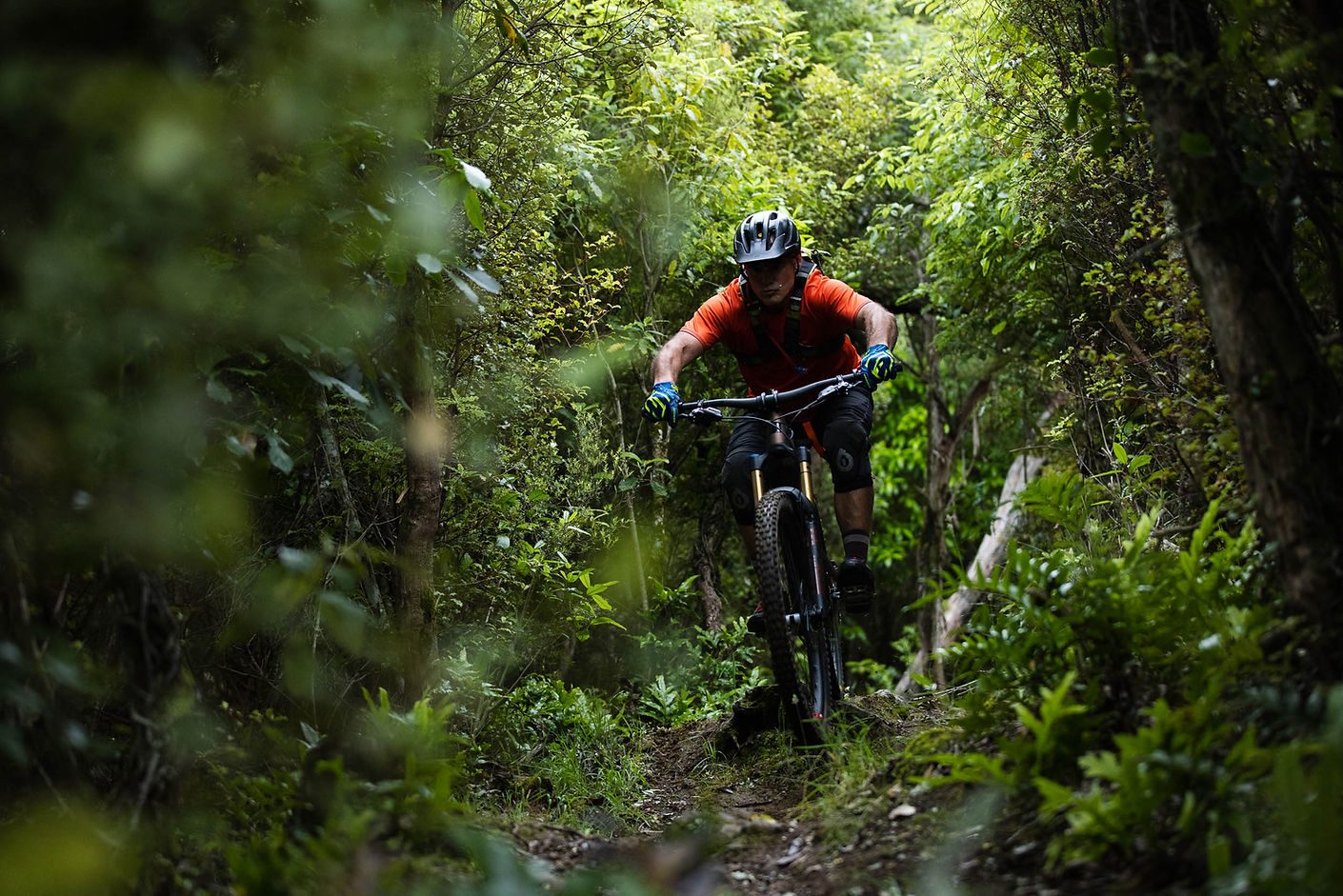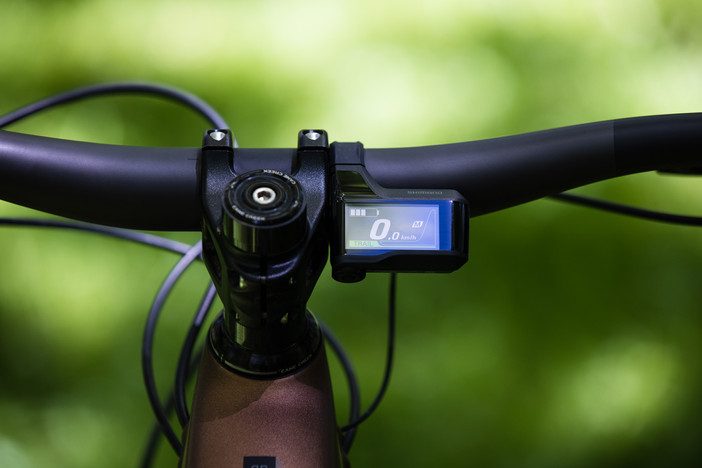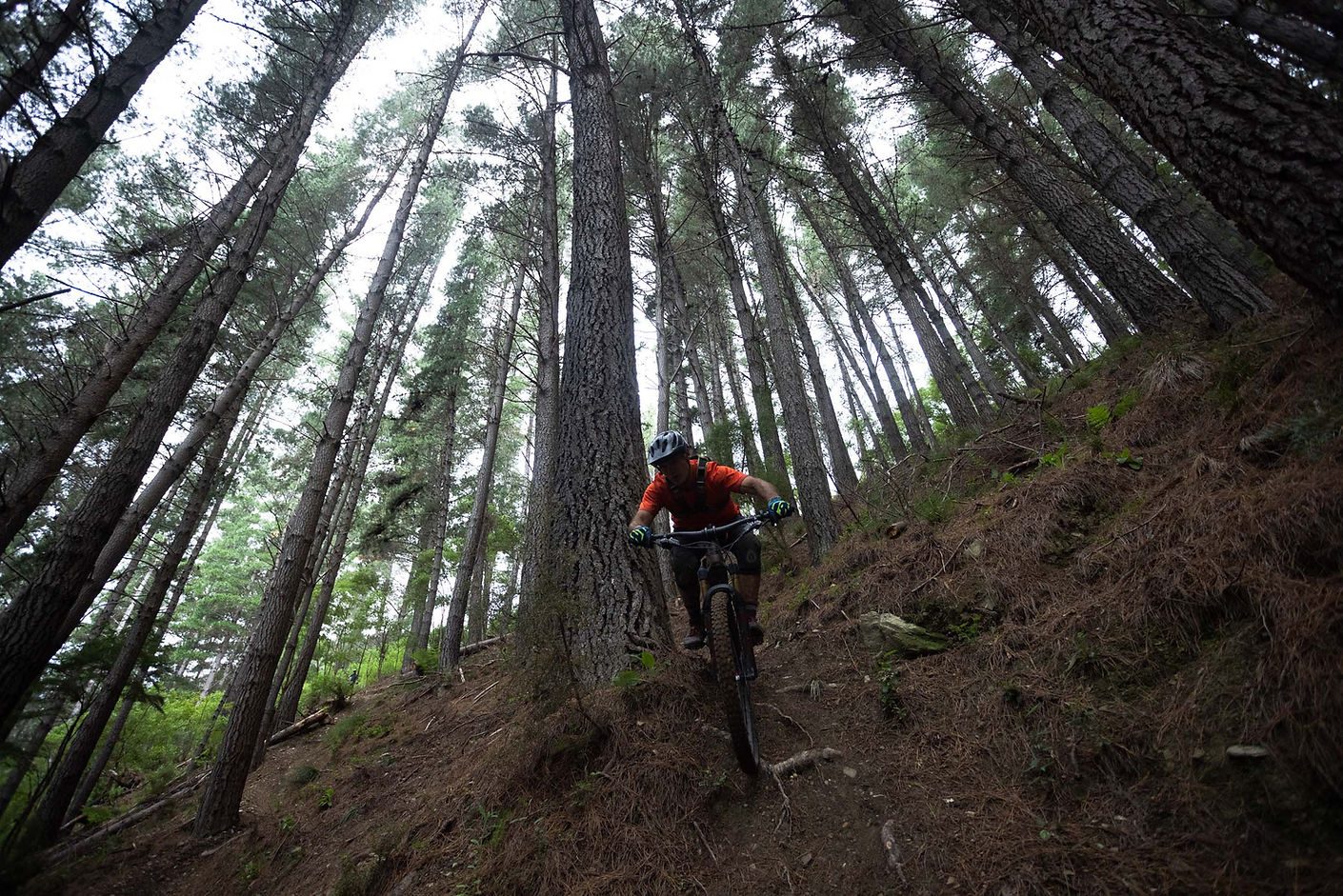I had two reference points coming into this review: the first was the original 1998-2005 Santa Cruz Bicycles Bullit; the second was Lt Frank Bullitt’s tyre-peeling, torque-monster of a Mustang Fastback from the 1968 movie of the same name. The first reference point provided a lot of context for this new version of the Bullit, given the original bike developed a bit of a cult following in freeride circles back in the day. The second reference point provided some unexpected context for how the new version of the Bullit performed on the trails.

Hyperformance Hardware (the NZ Santa Cruz Bicycles agent) set up a media camp in Nelson when the first two Bullits landed in NZ, with a brief to throw them at Nelson’s biggest hills and toughest trails. Like any good bike review, the weather was also organised just as well as the media camp schedule was, so we got the full gamut during three days of sweet riding.
So, what have we got here? In Santa Cruz Bicycle’s own words; the new Bullit takes a ‘no limits approach’, is unapologetic and with a spec and build that ‘reflect the smashability of the platform’. It is also ‘a bike for riders who seek V10 level terrain that’s out of range of any chairlift or shuttle road’. Bold claims. Have they been met?
Full disclosure #1 first: I realised pretty quickly that, subconsciously, I’ve been keeping myself at arm’s length from the pedal assist, mountain e-bike evolution that we are seeing in NZ and globally – for no good reason at all. I’ve already seen and experienced a rapid evolution in mountain bike design over my years of riding and racing. From what we were riding in the 90s, to what we are riding today, is nothing short of comparing a Model T to a Shelby Mustang. So why should jumping into the pedal assist e-bike space be any different? Well, my conclusion is – it shouldn’t be. What we are seeing is the natural, technology-based evolution of the mountain bike, giving nothing but good options for the trail rider. If you’re feeling a bit apologetic that you’re riding one, and maybe feeling like you have to make excuses for riding one, I reckon you should absolutely own it instead. We’re all part of the same space and having the same type of fun, so let’s just get over it and move on.

The Bullit is Santa Cruz Bicycle’s (SCB) second pedal assist e-bike. The first, the Heckler, also used a recycled model name – this is a clever approach from SCB, providing a level of continuity and connection with early models that we don’t normally see in the mountain bike industry. The Bullit embraces SCB’s MX platform (29” front, 27.5” rear), tried and proven in the World Cup downhill space with their V-10. MX is a very grown up way to describe this setup, with the informal ‘mullet’ usually the descriptor. Which brings me to full disclosure #2: I’ve been a mullet fan for several years now, and while the opportunity to rock one on my melon is long gone, the bike version absolutely fits with my riding style and the way I want a bike to perform. However, retrofitting a 27.5” or 29” bike to mullet configuration usually results in having to tolerate some level of geometry compromise, and that can be annoying. With my latest trail bike version, I have been able to get spot on with a fair bit of tweaking, so hopping on the Bullit for the first time felt immediately right and I was definitely in my happy place.
SCB have built the geometry of the Bullit around this MX style configuration, and that really is the only way to get the full roll-over, stability and increased traction benefits of the 29” front wheel, together with the cornering performance and flickability of the 27.5” rear wheel. The parts spec on the XO1 Coil build that I rode, was spot-on. Every component has been spec’d to support the desired use of the bike, and not a single component should need to be swapped out before throwing this bike at the trails. There will always be personal preference items that riders like to bring with them between bikes but, in this case, and even with my own little foibles in mind, there wasn’t anything I changed – or even remotely needed to change – before getting rowdy on this bronze machine.
The drive unit is Shimano’s latest EP8 motor with 630wh battery. This review alone could cover the full capability of this technology, but that’s not going to make for the sort of reading I suspect will fly. In summary though, this drive unit can be set to three modes – Eco, Trail and Boost – which are exactly as they look. Together with Shimano’s E-Tube phone app, using Bluetooth connection, each of those three power levels can be custom tuned around Assist Characteristics (eco through to powerful); Max Torque (20-85Nm) and Assist Start (mild through to quick). The permutations are endless, and setting the app up and changing any of those parameters is, thankfully, completely intuitive. Two full profiles can be setup as well, so it is simple to have something like a more flowing, full power/torque trail riding profile and a more gentle beech forest/technical riding profile stored- or even a dry roots and wet roots profile ready to go. This capability to custom tune settings is sure to provide endless fun for EP8 Bullit owners, and equates to a valuable trail-side tool giving the ability to tune the drive characteristics to the conditions. SCB went with Shimano drive units for the Heckler, and now the Bullit, due to the high level of international support, the natural/instinctive way they work, and their proven reliability. There is very little adaption time for the rider when hopping on one of these for the first time.






Our first day of riding was a bit of a shake down. Trails were reasonably dry and we hit some progressively harder trails as the afternoon wore on, including sessioning nasty, technical climbing sections that on a normal bike wouldn’t even be considered. My initial introduction and natural acceptance of the EP8 setup happened so quickly I was caught by surprise. Once I found the sweet spot around cadence, I was all over it. And that was a theme that ran through the media camp, regardless of what type of trail we were riding – when you’re working around that 80rpm cadence level, the world spins a bit slower. The first nasty, technical climbing section showed me that anticipation of gear selection, including using the single click shifter, needs to be slightly more advanced than on a non e-bike, to keep the motor working to deliver the right amount of torque and power through the drivetrain, to keep things surging forward. That learning again happened extremely quickly, and once sorted meant that ridiculously steep, rooty and slippery climbing sections of trail could be dealt with. It was relatively easy to get a feel for the torque assistance on these steep sections of trail too – constant pedalling pressure yielded great results, however, when climbing over steep, greasy root-infested sections of trail, some gentleness was needed to manage the torque. If front-back weight distribution was not quite right, even for the briefest of moments, things moved pretty quickly into Bullitt Fastback territory, with only the blue smoke missing! This is where the tuning capability of the motor really comes into its own, and dialling down the Torque, and possibly the Assist Start functions, will tailor the motor’s performance to the trail conditions, and desired performance. The bike does require a more deliberate technique with front/back weighting when climbing the technical, steep stuff though, with the drive system torque and power meshed in to provide more go-forward. It’s exactly the same technique as used on a non e-bike, but on steroids – the more deliberate the technique, the better the bike climbs. You definitely can’t just be a passenger on this bike and simply rely on the drive system to deliver in that sort of climbing terrain.
Our second day of riding kicked in after five hours of the sort of heavy spring rain we have had a lot of in Nelson this year. Trail plans were changed a wee bit as a result, with more of a focus on the lower areas of Fringed Hill to explore what the bike would do across a wider range of trail type. Day three took us to exactly the type of terrain this bike is designed for: steep, long climbs; technical, rooty and rocky linking tracks; and steep, rooty grade five goodness.
For me, slamming the bars on the large size bike was the only structural change I made, and it put me straight into a familiar mode of riding that usually only comes with a triple clamp fork setup. The front end of the Bullit encouraged that approach, with the Fox 38’s proving to be ridiculously solid and composed under severe front-end weighting and aggression. Non-plus size Double Down Assegai (2.5 front) and DHR II (2.4 rear) tyres give an obvious signal of the intentions of the bike, and are a welcome, important and entirely appropriate part of the overall spec, absolutely supporting the aggressive intentions of the bike. These same tyres are specced on all the different models of Bullit (as is the same CC carbon frame and EP8 drive unit), so SCB aren’t scrimping in that department.

Carrying on the front-of-the-bike theme, two areas in particular stood out. How the bike took and held a line across off-camber, root infested trail sections was stunning – the combo of a fork with minimal lateral deflection, good damping performance and the super aggressive front tyre all working together to encourage line choice that would otherwise be off the table. Also, pushing the front of the bike through steep, deep holes and transitions was rock solid. No suggestion of the front of the bike ever getting hung up on even the nastiest of trail sections was a real confidence-inspiring characteristic. Big rotor Code brakes (220mm front, 200 rear) were right at home in that steep environment, with oodles of power modulation always on tap, and no fading to speak of at all – that says a lot about SCB’s approach to parts spec on these bikes.
Our wet day of riding showed two surprising traits with this bike that are well worth mentioning. The first is how receptive the bike is to hooking up on slippery surfaces when feeding constant weight through the middle of the bike – it was amazing. This trait alone yielded a lot of riding joy, and epitomised the ‘ride it like its dry’ mantra that is always the go-to for riding the slippery stuff. The weight of the bike and its low centre of mass sitting on those aggressive tyres worked in complete harmony to provide gobs of traction. The other trait that popped up in these conditions, that was a little unexpected, was how well the bike responded to being weighted and unweighted – natural trail pumping. The suspension platform provided plenty of support when getting aggressive in this area, and the bike responded in kind with making massive amounts of traction where needed, but also when getting its float on to glide over those sections of trail that required lightness. This was unexpected for me, as the weight of the bike had no real detrimental effects on this playful style of riding.
When the fickle Nelson weather took a break, it opened up a last minute opportunity to give the Bullit a run on some more open style, flowy type trails. Nelson’s classic ‘riding on marbles’ dry surface was the connection for this, and it showed some traits of the bike that might not have been fully evident in the technical style of riding we had been doing. Stability at speed was no problem at all, as was making traction where needed (see above), but the open stuff highlighted the need to get really aggressive with the body English to make this bike sing. A soft approach doesn’t gel with the Bullit – it begs you, as the pilot, to give it the firm prompts it requires to do its thing. The harder it is thrown, pushed and directed at the trail, the more the overall package responds.
Of course, a bit of jumping had to be factored in during our riding days – it would have been rude not to. E-mountain bike riders who like a bit of air time usually tell the same story when asked how their bikes perform in the air, and it was great to be able to confirm that on the Bullit. Not only does normal jumping technique apply, but the weight of the bike adds a ramped up level of stability when in the air. It sort of makes a lightweight trail bike feel just a wee bit sensitive! So jumping performance gets the big tick too. And – just a quick comment on the bike’s weight: SCB quote just under 23kg for the XO1 Coil we rode. That is a true weight, and considering the coil shock and downhill tyre spec, it reflects very favourably on the overall package. Compared to most other bikes in this category, it is definitely at the lighter end of the scale.

Without getting all tied up in watt hours, power settings etc, a five hour hard ride took us into one-bar-battery-remaining territory which, depending on power setting to get you home, was in the realm of about a 15km back-up range. That was after five hours of hard riding and climbing at pace. For my legs and lungs, the load we were climbing at was very close to my normal riding, but at three to four times the pace. That surprised me too, and I’ve come away from this review having dispelled any suspicion that pedal assist mountain bike riding might be too easy. Of course you can cruise, but using the drive system to its full capability becomes a new normal very quickly. I honestly didn’t realise just how quick we were climbing on these bikes until we came up behind non e-bikes.
I’d say Santa Cruz Bicycles have met their claims with the Bullit. They are bold claims, but so is this bike. Yes, it’s got some weight to it, but it didn’t take much time on the bike for that weight to be pretty much forgotten; the overall package just works so well. Yes, it’s a lot of coin too, but it’s also an awful lot of bike and probably represents the sharp edge of where this technology is at. The spirit of the original Bullit lives strong in this new model, and I reckon that the King of Cool, Steve McQueen, would have approved if this Bullit had been around in his time.
Distributed by Hyperformance
Words: Chris Mildon
Images: Henry Jaine

